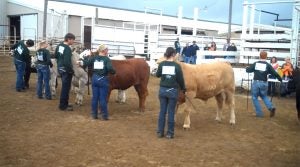Anyone who has ever walked through a show barn or sat in on a judge’s set of reasons can attest to the strange, surreal atmosphere and energy that encapsulates the stock show world. Be it your standard, humble county fair or atop the most prestigious colored shavings, the healthy competition and showcase of livestock genetics is absolutely invigorating.
Year round, you can find small caravans from little map dot towns carrying a week’s worth of gear in weathered stock trailers. They’ll trek across many state lines battling heat or snow. And it’s all done to gamble countless hours and dollars, settle into dusty, hazy barns, and eat overpriced burgers and crockpot dinners atop a show box — in the high hopes of a champion slap. Or is there more to it all? There must be because, after all, the same faces show up year after year knowing they’ll never hold a purple banner.
On the surface level, there is nothing practical about showing livestock. It’s labor intensive, taking away from the actual money-making activities on the home farm. Some argue flashy, fancy club animals aren’t worth a dime beyond accumulated ribbons and hardware. Not to mention, thanks to the delicate intricacies that comprise a show, more things can go wrong than you can imagine. If any sane fair-goer or curious bystander were to even slightly peel back the curtain on what goes into chasing the “tanbark trail,” they’d be aghast.

A rare energy hits the veins — be it cruising the show barn or stepping under arena lights. We know the whole thing is madness, of course, but there are those moments happening only under arena lights, telling why they all do it.
I’ve seen judges moved to tears as they stepped out to select their champion, recalling first the calf, lamb, kid, foal or gilt their father bought them and coming in dead last. Now here they stand, humbled to grace the arena years later judging the best of the best. I think that’s why they showed.
I knew why one family showed when I heard a toddler scream, “Daddy!” as a grand old Holstein was tapped Grand Champion.
When I’ve walked into the homes of so many farmers and saw the faded banners surrounded by generational photos with their winning homebred animals, I think I knew why they showed.
Whenever I see young kids playing with their newfound friends in dusty show barn alleys, I think I know why their parents want them to show.
Every time I’ve seen a child cry into the arms of an understanding parent after a disappointing class, I understand. In spite of the work to hand raise, fit and work an animal to be the best version of itself only to come in dead last, there was a reason why they still showed.
Pay close attention and you may catch a seasoned senior showman taking a spare moment, or spare hour, to help little “Freddy 4-Her” properly fit their animal. That’s probably why they show.
The allure of watching fine animals parading in a circle, each with an unknown pedigree at the mercy of one judge’s opinion on that particular day is interesting. But maybe, the human connection such events conjure within is a lot deeper and less mysterious than it seems.
After all, you may watch those “showbarn rats” grow up only to return with families of their own. Maybe they’ll wipe a tear as they hand off a fresh halter or show stick to their eldest child and send them on their way into the crazy world. And they’ll watch them faded into washed out arena lights with a nod recalling, this is why we show.
Jaclyn Krymowski is a graduate of The Ohio State University with a major in animal industries and minor in agriculture communications. She is an enthusiastic agvocate, professional freelance writer, and blogs at the-herdbook.com.



